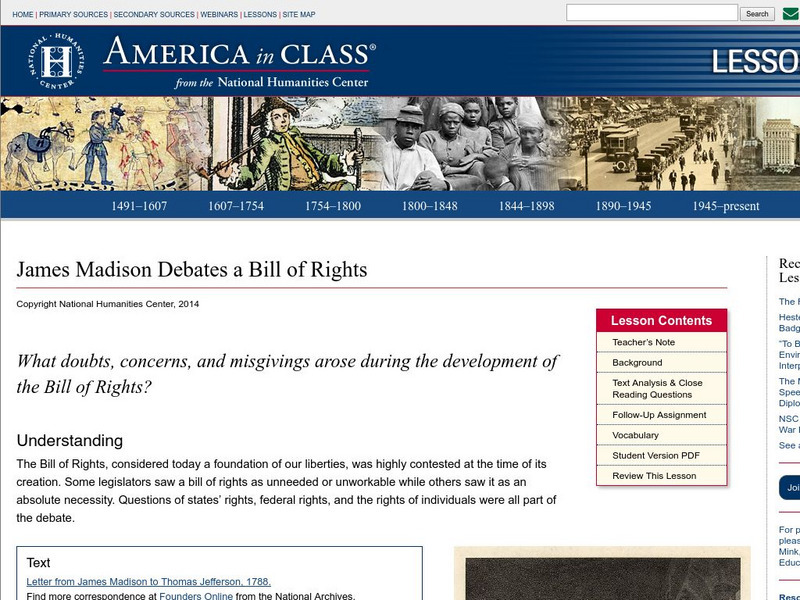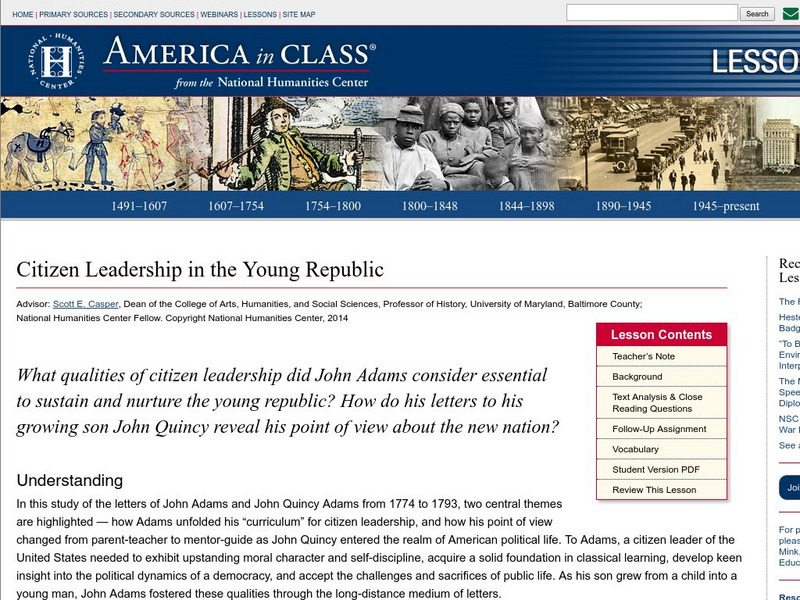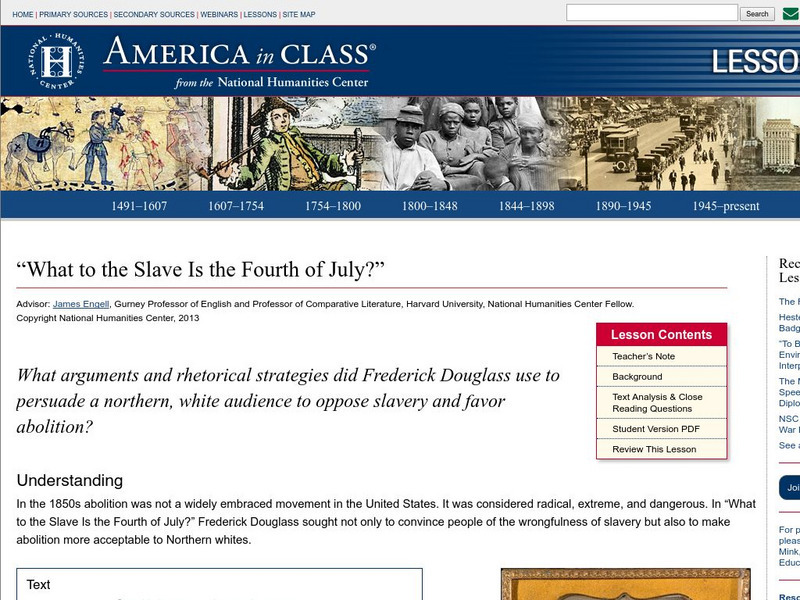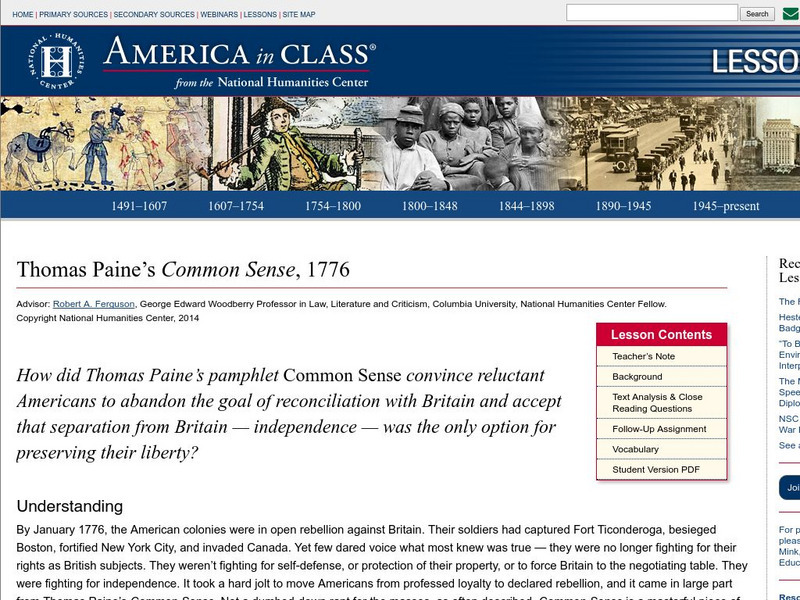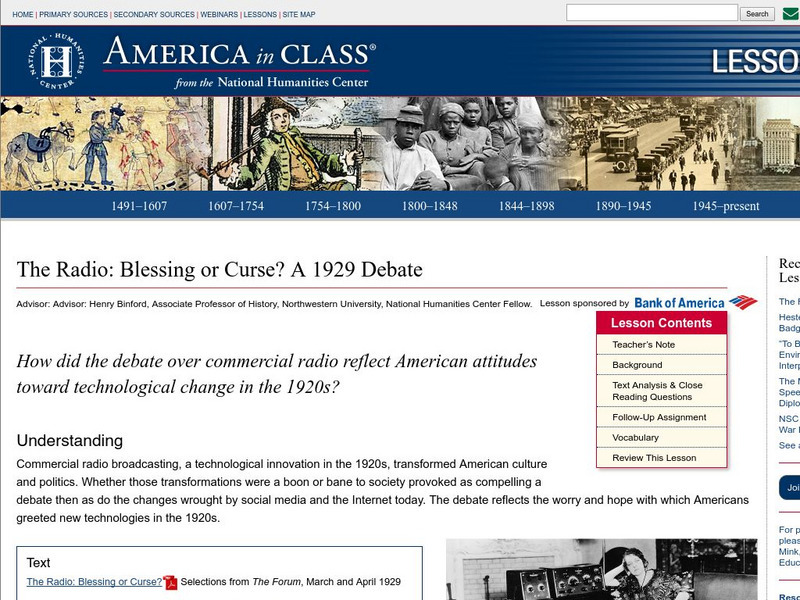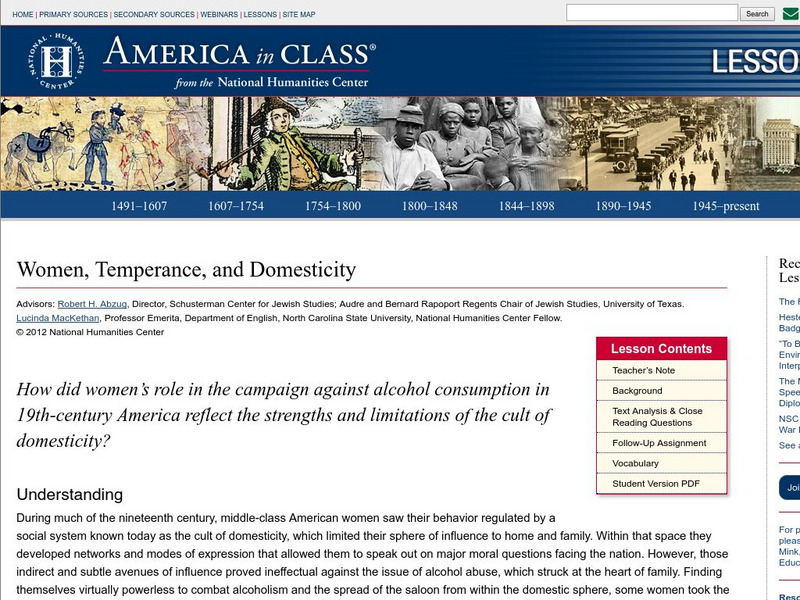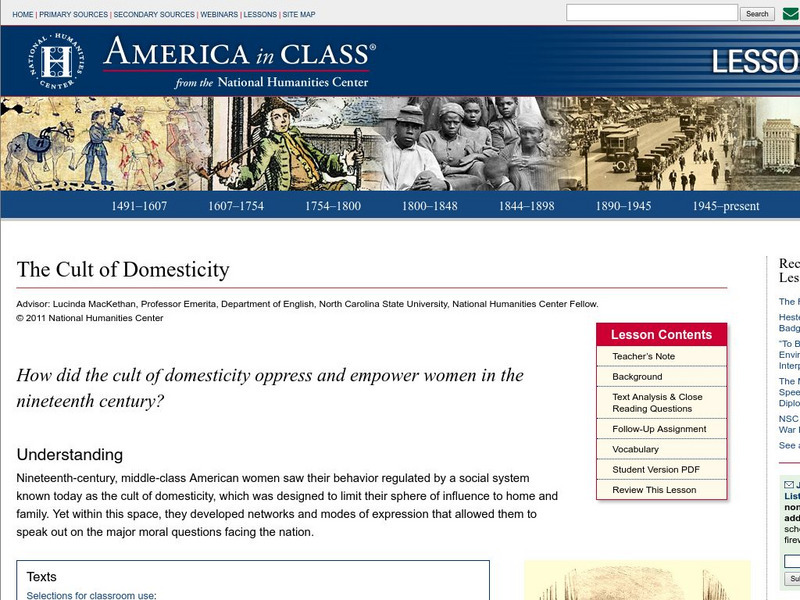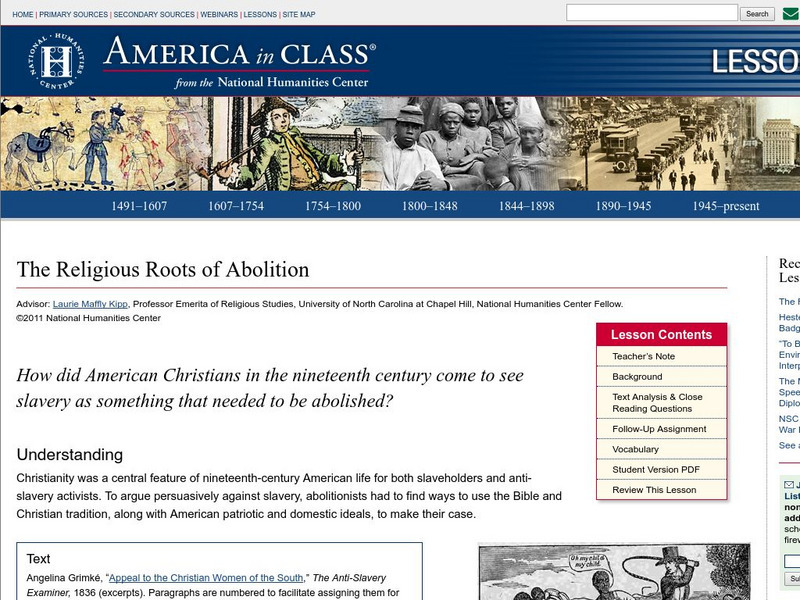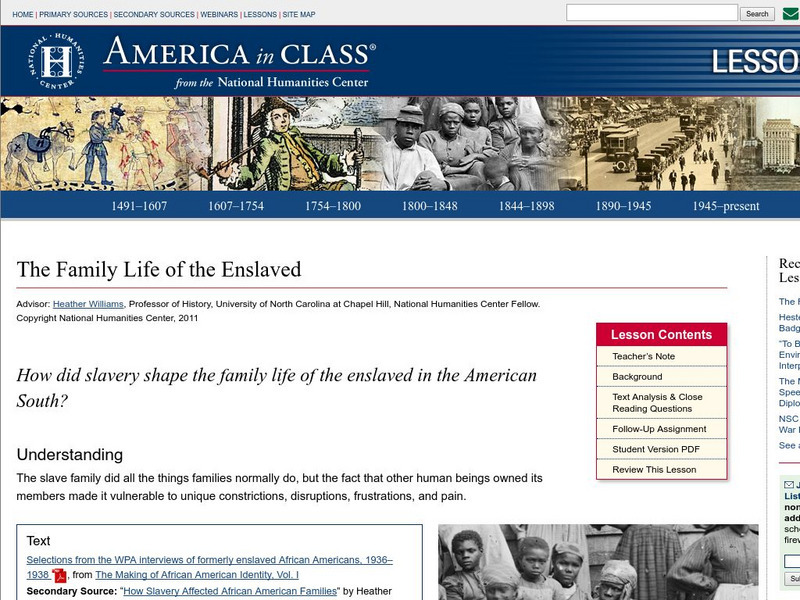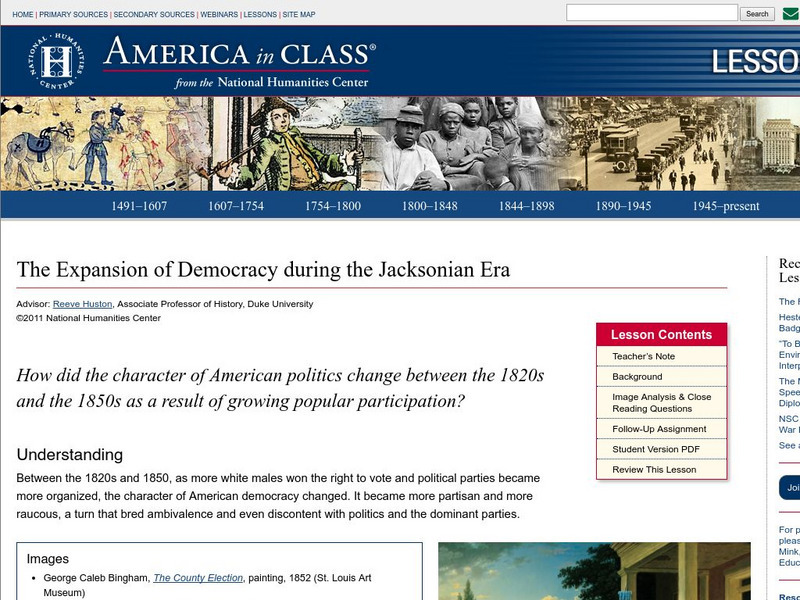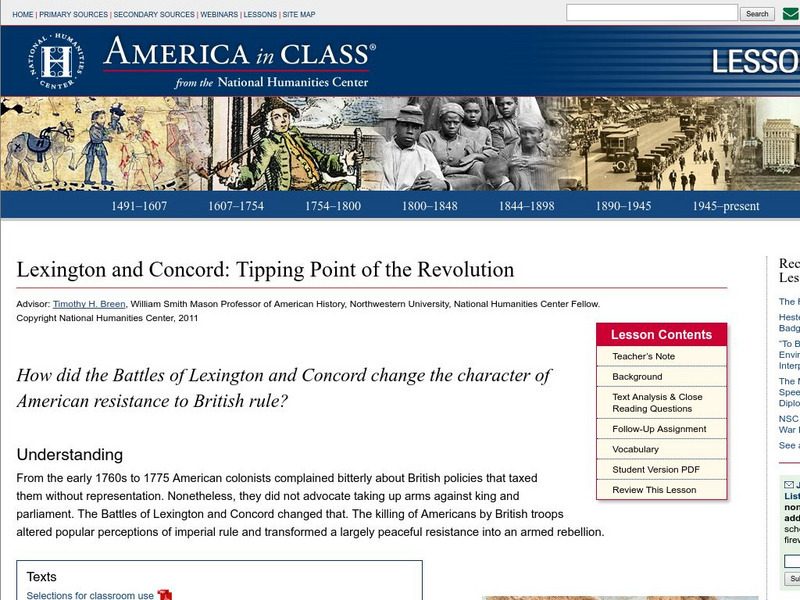National Humanities Center
National Humanities Center: America in Class: The Columbian Exchange
Lesson on the Columbian Exchange and the unintended consequences that resulted. Lesson includes teacher's notes, primary or secondary sources, background, strategies for analysis and Close reading, follow-up assignment and vocabulary.
National Humanities Center
National Humanities Center: America in Class: James Madison Debates the Bill of Rights
Lesson from the National Humanities Center explores the doubts, concerns, and misgivings surrounding the development of the Bill of Rights. Primary or secondary sources, text analysis and Close reading strategies, background notes, and...
National Humanities Center
National Humanities Center: America in Class: Thoreau's Critique of Democracy in "Civil Disobedience"
National Humanities Center lesson plan explores the criticisms Thoreau makes about a representative democracy form of government. Lesson includes interactive assignments, teacher notes, strategies for Close reading, follow-up and...
National Humanities Center
National Humanities Center: America in Class: Individualism in Ralph Waldo Emerson's "Self Reliance"
Lesson on Emerson's views about self-reliance and individualism and how embracing those ideas affects society. Contents include teacher notes, vocabulary, background information, text analysis and Close reading questions.
National Humanities Center
National Humanities Center: America in Class: Citizen Leadership in the Young Republic
Lesson on citizen leadership explores the point of view of John Adams on essential qualities of leadership and a new nation. Lesson content includes background, text analysis and Close Reading questions, vocabularyand teacher's notes....
National Humanities Center
National Humanities Center: America in Class: "What to the Slave Is the Fourth of July?"
Explores the argument made by Frederick Douglass and his appeals to convince northern whites to oppose slavery and favor abolition. Lesson content includes resources for both teachers and learners.
National Humanities Center
National Humanities Center: America in Class: The Airplane as a Symbol of Modernism
Through art and text, lesson explores Modernism through the airplane as a symbol in the 1920s. Content includes questions for analysis and discussion, follow-up, and guide for discussing art.
National Humanities Center
National Humanities Center: America in Class: Progressivism in the Home
National Humanities Center lesson explores an era of progressivism, 1890-1920s, and examines how a scientific approach changed the concept of homemaking. Lesson contents include teachers notes, background, text analysis and close reading...
National Humanities Center
National Humanities Center: America in Class: The Enslaved and the Civil War
National Humanities Center lesson on how enslaved African Americans in the South undermined the Southern cause during the Civil War. Lesson contents includes primary sources material, strategies for text analysis, vocabulary, and...
National Humanities Center
National Humanities Center: America in Class: Abigail Adams and "Remember the Ladies"
Lesson using primary resource to explore how Abigail Adams's famous appeal to "Remember the Ladies" is a reflection of the status of women in eighteenth-century America.
National Humanities Center
National Humanities Center: America in Class: The Chinese Question From a Chinese Standpoint, 1873
Lesson on how the Chinese in California confronted anti-Chinese sentiment and discrimination in the late 1800s. Comprehensive lesson with primary source materials.
National Humanities Center
National Humanities Center: America in Class: Aylmer's Motivation in Nathaniel Hawthorne's "The Birthmark"
Lesson on why Aylmer, the protagonist of Nathaniel Hawthorne's story "The Birthmark," undertakes his fatal experiment. Lesson contents contain literary text, strategies for analysis, and vocabulary.
National Humanities Center
National Humanities Center: America in Class: Thomas Paine's Common Sense, 1776
Lesson on how Thomas Paine's pamphlet Common Sense convinced reluctant Americans to abandon the goal of reconciliation with Britain and accept independence as the only option for preserving their liberty.
National Humanities Center
National Humanities Center: America in Class: Benjamin Franklin's Satire of Witch Hunting
Lesson uses primary resource to explore Benjamin Franklin's satire of a witch trial and his argument that human affairs should be guided, above all, by reason.
National Humanities Center
National Humanities Center: America in Class: The Radio: Blessing or Curse? A 1929 Debate
Lesson on how the debate over commercial radio reflected American attitudes toward technological change in the 1920s. Includes teacher notes, background, strategies for text analysis and close reading questions as well as follow-up and...
National Humanities Center
National Humanities Center: America in Class: Progressivism in the Factory
Lesson on Progressivism in the Factory uses primary resources to explore how Americans defined progress during the Progressive Era. Comprehensive content for lesson.
National Humanities Center
National Humanities Center: America in Class: Women, Temperance Reform, and the Cult of Domesticity
Lesson on how women's role in the campaign against alcohol consumption in 19th-century America reflected the strengths and limitations of the cult of domesticity. Complete set of resources for a comprehensive study.
National Humanities Center
National Humanities Center: America in Class: The Cult of Domesticity
A lesson that looks at the place of women in nineteenth century America. While their role that was constrained by societal expectations, they still wielded political power in subtle ways.
National Humanities Center
National Humanities Center: America in Class: The Religious Roots of Abolition
A lesson that looks at the role of Christianity in the fight to abolish slavery in the United States.
National Humanities Center
National Humanities Center: America in Class: A Pro Slavery Argument, 1857
A lesson that explores the argumments made by pro-slavery proponents in the United States prior to abolition.
National Humanities Center
National Humanities Center: America in Class: Slavery and the Family Life of the Enslaved
A lesson that looks at how slavery impacted on the slaves' family lives in the United States.
National Humanities Center
National Humanities Center: America in Class: Expansion of Democracy During the Jacksonian Era
Lesson where students explore the emergence of the American system of democracy and political parties between 1820 and 1850. Using paintings by George Caleb Bingham and Richard Caton Woodville, and a political cartoon depicting the...
National Humanities Center
National Humanities Center: America in Class: The Expansion of Democracy During the Jacksonian Era
Lesson on how the character of American politics changed between the 1820s and 1850s as a result of growing popular participation. Complete set of resources including primary source material, teacher notes, vocabulary, and strategies for...
National Humanities Center
National Humanities Center: America in Class: Lexington and Concord: Tipping Point of Revolution
Lesson where students examine primary texts from 1775 and 1776 to explore the impact of the Battles of Lexington and Concord on people's attitudes towards the British. Up to that point, protests against the British had not been violent,...

